Sintered Steel Market by Type (Stainless Steel, Carbon Steel, Alloy Steel, Tool Steel), Process (Metal Injection Moulding, Additive Manufacturing, Conventional Manufacturing), End-Use, Application, & Region - Global Forecast 2028
Sintered Steel Market
Sintered Steel Market is projected to grow from USD 24.4 billion in 2023 to USD 29.5 billion by 2028, at a cagr 3.9% during the forecast period. The market growth is driven by growing manufacturing and industrial sector. The industrialization and infrastructure development in emerging economies, such as China, India, and Southeast Asian countries, have increased the demand for sintered steel. The rapid urbanization, construction activities, and industrial growth in these regions drive the demand for sintered steel components in various sectors. Sintered steel finds applications in various industries, including machinery, construction, aerospace, and consumer goods. The increasing production activities and infrastructure development contribute to the demand for sintered steel components.
Attractive Opportunities in the Sintered Steel Market
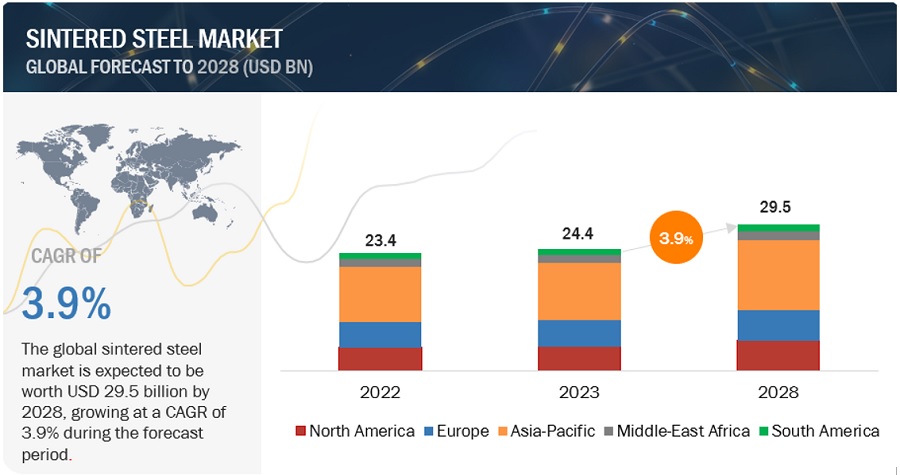
To know about the assumptions considered for the study, Request for Free Sample Report
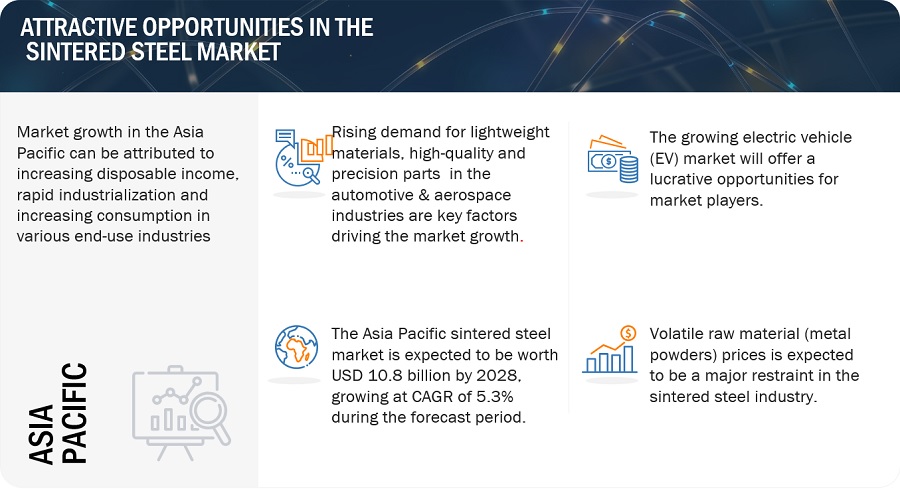
Sintered Steel Market Dynamics
Driver: Growing automotive industry
The growing automotive industry plays a significant role in driving the growth of the sintered steel market. The automotive industry is a major consumer of sintered steel components. As the global automotive production continues to rise, there is a higher demand for sintered steel parts in various vehicle systems. Sintered steel components are used in engines, transmissions, brakes, steering systems, fuel systems, and many other applications within vehicles. Sintered steel offers cost advantages over other manufacturing methods. The sintering process allows for efficient use of raw materials, reducing material waste and production costs. As the automotive industry seeks cost-effective solutions without compromising quality and performance, sintered steel becomes an attractive choice for various components. The growing automotive industry's focus on lightweighting, cost-efficiency, complex shapes, and high-performance applications aligns with the strengths of sintered steel. This synergy between the automotive industry's needs and the advantages of sintered steel drives its adoption and contributes to the growth of the sintered steel market.
Restraint: Volatile raw material (metal powders) prices
Raw material price fluctuations can be a considerable restraint for the sintered steel market, affecting the profitability and competitiveness of sintered steel companies The main raw materials required for sintered steel production include various metal powders such as iron, steel, tin, nickel, copper, molybdenum, and aluminum. When the cost of these raw materials increases, the cost of production increases. If sintered steel companies pass on these increased costs to their customers, they may lose business to competitors who can offer lower prices.
Opportunities: Growing electric vehicle (EV) market
The growing electric vehicle (EV) market presents significant opportunities for the sintered steel market. Electric vehicles require a range of specialized components, including electric motor cores, battery contacts, connectors, and power electronics. Sintered steel is well-suited for manufacturing these components due to its magnetic properties, high conductivity, and good dimensional accuracy. As the EV market expands, there will be a surge in demand for these sintered steel components, creating new opportunities for manufacturers.
Challenges: Material limitations
The mechanical properties of sintered steel, including strength, toughness, and fatigue resistance, can be influenced by factors such as powder composition, powder particle size distribution, and sintering conditions. Achieving specific mechanical properties can be challenging, and sintered steel may not always match the performance of other materials, such as forged steel or certain alloys, in demanding applications.
Despite these challenges, sintered steel remains widely used in various industries due to its advantages in terms of cost-effectiveness, complex shape capabilities, and the ability to produce large quantities of components with good mechanical properties. Manufacturers continuously work on improving sintering techniques and developing new materials to address these challenges and expand the application potential of sintered steel.
Ecosystem
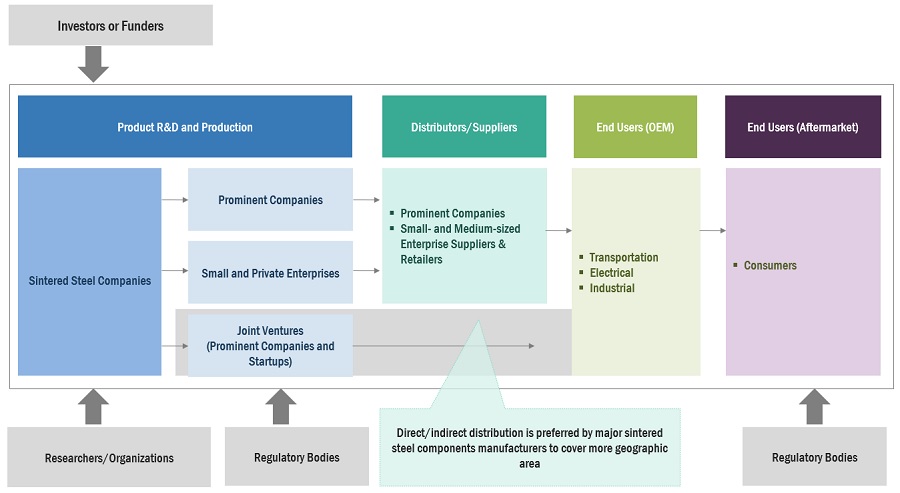
By Steel Type, Tool steel accounted for the highest CAGR during the forecast period
Tool steel is a type of high-speed steel used in tool production. It is manufactured through a process that involves pressing powdered tool components to achieve the desired shape and density. This near-net-shape manufacturing technique reduces the need for extensive machining and allows for precise shaping. To enhance its properties, hot-temperature cemented carbides are added to the tool steel, ensuring optimal density and uniform carbide distribution. The resulting high-density tool steel exhibits excellent grindability and possesses desirable characteristics such as hardness, wear resistance, and toughness. These qualities make tool steel suitable for a wide range of tool applications in industries such as manufacturing, construction, automotive, aerospace, and woodworking. It is commonly used to create various tools, including drills, cutting blades, punches, dies, molds, and tooling components.
By Process, Additive manufacturing accounted for the highest CAGR during the forecast period
The additive manufacturing (Am) is the fastest growing in the sintered steel market during the forecast period. Additive manufacturing is experiencing rapid growth in the sintered steel market due to several factors. It offers design freedom, allowing the creation of complex geometries and customized parts. The reduced material waste and improved manufacturing efficiency make it cost-effective. Additive manufacturing enables faster prototyping and shorter time-to-market. It also provides increased design flexibility and customization options. Advancements in materials and technology have expanded its capabilities, leading to higher densities and improved mechanical properties in sintered steel products. Overall, additive manufacturing is driving innovation and transforming the manufacturing landscape in the sintered steel market.
By Application, Engines accounted for the highest CAGR during the forecast period
Engine applications dominate the sintered steel market. This is primarily due to the exceptional mechanical properties offered by sintered steel, including high strength and wear resistance, which make it well-suited for engine components operating under extreme conditions. The cost-effectiveness of sintered steel, achieved through near-net shape production and reduced material waste, appeals to engine manufacturers seeking efficient solutions. Furthermore, the design flexibility of sintered steel allows for the creation of customized and intricate shapes, enhancing engine performance. The strong demand from the transportation industry, along with the continuous growth in vehicle production and technological advancements, further contributes to the significant presence of engine applications in the sintered steel market.
By End Use Sector, Electrical accounted for the highest CAGR during the forecast period
The demand for sintered steel in the electrical industry is driven by the increasing adoption of renewable energy sources, such as wind and solar power. Sintered steel is utilized in the manufacturing of electrical contacts, connectors, and other components for renewable energy systems. As the renewable energy sector continues to expand, the demand for sintered steel in this industry is expected to grow significantly.
Sintered steel, with its high thermal conductivity, can aid in heat dissipation in electrical applications. It is often used in heat sinks and thermal management solutions, where it helps transfer heat away from sensitive electrical components, preventing overheating and ensuring efficient operation.
Asia Pacific is projected to account for the highest CAGR in the sintered steel market during the forecast period
The Asia Pacific region, particularly countries like China and India, is undergoing rapid industrialization and urbanization. This has led to increased demand for various sectors, including automotive, construction, and machinery, which are major consumers of sintered steel products. The expanding industrial base and infrastructure development projects are driving the growth of the sintered steel market in the region.
The Asia Pacific region is one of the largest automotive manufacturing hubs globally. Sintered steel components are extensively used in the automotive sector for applications such as engine parts, transmission components, bearings, and braking systems. The increasing production of vehicles in countries like China, Japan, India, and South Korea has propelled the demand for sintered steel in the region.
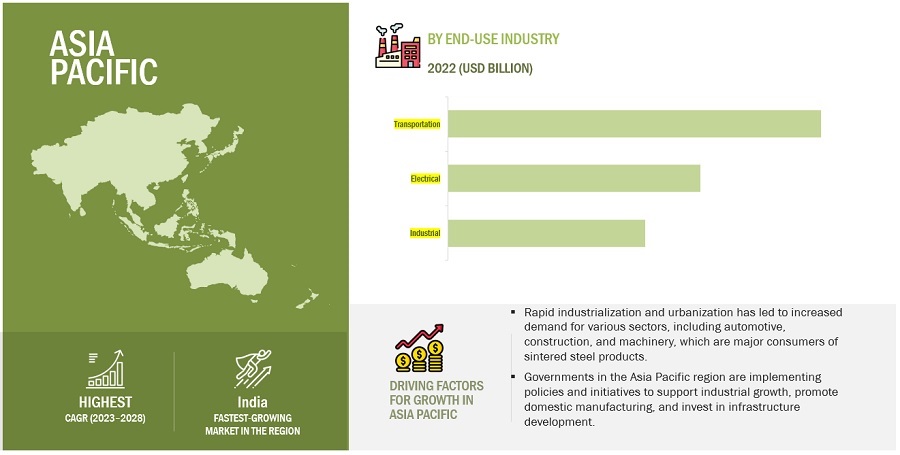
To know about the assumptions considered for the study, download the pdf brochure
Key Market Players
Sintered steel market comprises key manufacturers such as Sumitomo Electric Industries Limited (Japan), GKN Powder Metallurgy (UK), Samvardhana Motherson Group (India), Resonac (Japan), The Miba Group (US), ASCO Sintering Co. (US), Schunk Sinter Metals (Germany), AMES Sintering Metallic Components (Spain), and Sintercom India Ltd. (India) and others. Expansions, acquisitions, joint ventures, and new product developments are some of the major strategies adopted by these key players to enhance their positions in the sintered steel market. Major focus was given to the new product development due to the changing requirements of transportation and electronics product consumers across the world.
Get online access to the report on the World's First Market Intelligence Cloud
- Easy to Download Historical Data & Forecast Numbers
- Company Analysis Dashboard for high growth potential opportunities
- Research Analyst Access for customization & queries
- Competitor Analysis with Interactive dashboard
- Latest News, Updates & Trend analysis
Request Sample Scope of the Report
:
Get online access to the report on the World's First Market Intelligence Cloud
- Easy to Download Historical Data & Forecast Numbers
- Company Analysis Dashboard for high growth potential opportunities
- Research Analyst Access for customization & queries
- Competitor Analysis with Interactive dashboard
- Latest News, Updates & Trend analysis
|
Report Metric |
Details |
|
Years Considered |
2021–2028 |
|
Base year |
2022 |
|
Forecast period |
2023–2028 |
|
Unit considered |
Value (USD Million/Billion), Volume (Tons) |
|
Segments |
Type, Process, Application, and Region |
|
Regions |
North America, Asia Pacific, Europe, South America, and Rest of the World |
|
Companies |
The major players are Sumitomo Electric Industries Limited (Japan), GKN Powder Metallurgy (UK), Samvardhana Motherson Group (India), Resonac (Japan), The Miba Group (US), ASCO Sintering Co. (US), Schunk Sinter Metals (Germany), AMES Sintering Metallic Components (Spain), and Sintercom India Ltd. (India). |
This research report categorizes the global sintered steel market based on Steel Type, Process, Application, and Region
On the basis of Steel Type:
- Stainless Steel
- Carbon Steel
- Alloy Steel
- Tool Steel
On the basis of Process:
- Metal Injection Molding (Mim)
- Additive Manufacturing (Am)
- Conventional Manufacturing
- Powder Forged Manufacturing
On the basis of Application:
- Engines
- Transmissions
- Bodies
- Chassis
- Drivetrains
- Electrical Appliances
- Others
On the basis of End Use Industry:
- Transportation
- Electrical
- Industrial
- Others
On the basis of Region:
- North America
- Asia Pacific
- Europe
- South America
- Rest of the World
The market has been further analyzed for the key countries in each of these regions.
Recent Developments
- In March 2023, A definitive license agreement was signed by Sumitomo Electric Industries Ltd. and US Conec Ltd., allowing Sumitomo Electric Lightwave Corp. to produce MMC connector and TMT ferrule components for the use in the deployment of next-generation, high-density, multi-fibre cable solutions.
- In May 2023, Sumitomo Electric Industries, Ltd. and the National Institute of Information and Communications Technology (NICT) have jointly achieved a major breakthrough in optical fibre technology. They have developed a multi-core optical fibre with an impressive 19 cores, which is the largest number of cores ever achieved in a standard outer diameter (0.125 mm) fibre. They successfully transmitted data at a staggering speed of 1.7 petabits per second over 63.5 km.
- Resonac, formed on January 1, 2023, through the merger of Showa Denko and Showa Denko Materials (formerly Hitachi Chemical), marks a new beginning for the company. Their goal is to achieve global leadership in the chemical industry by prioritizing advanced functional materials and continuous transformation initiatives.
- In October 2021, For the development of multicore optical fibre cable, Sumitomo Electric Industries, Ltd. partnered with OCC Corporation, a fully owned subsidiary of NEC Corporation.
- In May 2019, Sumitomo Electric Industries, Ltd. acquired 100% shares of the European manufacturers of powdered metal components, Sinterwerke Herne GmbH (SWH, Germany) and Sinterwerke Grenchen AG (SWG, Switzerland). Its Powder Metal Products Division operates globally along with Sumitomo Electric Sintered Alloy Ltd.
Frequently Asked Questions (FAQ):
What are the major drivers driving the growth of the sintered steel market?
The sintered steel is expected to witness significant growth in the future due to growing automotive industry, growing manufacturing & industrial sector.
What are the major challenges in the sintered steel market?
The major challenges in the sintered steel market are low awareness of powder metallurgy technology and material limitations.
What are the restraining factors in the sintered steel market?
The major restraining factor faced by the sintered steel market are volatile raw material (metal powders) prices and competition from alternative materials.
What is the key opportunity in the sintered steel market?
Growing electric vehicle (EV) market and emerging technological advancements in the powder metallurgy industry are key opportunity in the sintered steel market.
What are the end-use industries where sintered steel components are used?
The sintered steel components are majorly used in transportation, electrical, industrial equipment manufacturing industries. .
To speak to our analyst for a discussion on the above findings, click Speak to Analyst
Extensive secondary sources, directories, and databases such as Hoovers, Bloomberg BusinessWeek, Factiva, and OneSource have been used to identify and collect information for this technical, market-oriented, and commercial study of the sintered steel market. In-depth interviews were conducted with various primary respondents which included key industry participants, subject matter experts (SMEs), C-level executives of key industry players, and industry consultants, among other experts, to obtain and verify critical qualitative and quantitative information and to assess prospects.
Secondary Research
In the secondary research process, various secondary sources have been referred to for identifying and collecting information for this study. Secondary sources included annual reports, press releases, and investor presentations of companies; white papers; publications from recognized websites; and databases. Secondary research has mainly been used to obtain key information about the supply chain of the industry, the total pool of key players, market classification & segmentation according to the industry trends to the bottom-most level, regional markets, and key developments from both, market- and technology-oriented perspectives.
The market size of sintered steel has been estimated based on secondary data available through paid and unpaid sources, and by analyzing the product portfolios of key companies. This data has been further validated through various primary sources.
Primary Research
The sintered steel market comprises various stakeholders in the supply chain and includes suppliers, manufacturers, and end-product manufacturers. Various primary sources from the supply and demand sides of the sintered steel market have been interviewed to obtain qualitative and quantitative information. Primary participants from the supply side include key opinion leaders, executives, vice presidents, and CEOs of companies in the market. Primary sources from the demand side include experts from end-use industries, associations, and institutions involved in the market, and key opinion leaders.
Following is the breakdown of primary respondents
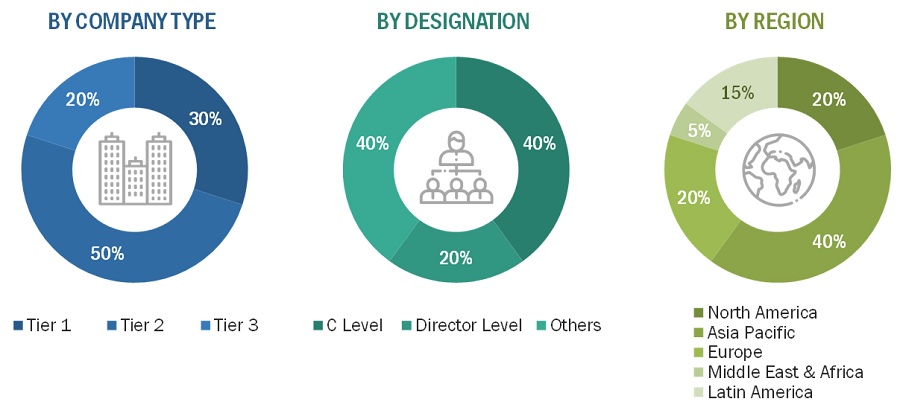
Notes: *Others include sales, marketing, and product managers.
Tier 1: >USD 5 Billion; Tier 2: USD 1 Billion– USD 5 Billion; and Tier 3: <USD 1 Billion.
To know about the assumptions considered for the study, download the pdf brochure
Market Size Estimation
The supply-side and demand-side approaches have been extensively used, along with several data triangulation methods, for market size estimation and forecast of the overall market segments listed in this report. Extensive qualitative and quantitative data were analyzed to list key information/insights throughout the report. The research methodology used to estimate the market size includes the following:
- The key players in the industry were identified through extensive secondary research.
- The supply chain of the industry and market size, in terms of value and volumn, were determined through primary and secondary research.
- All percentage shares split, and breakdowns were determined using secondary sources and verified through primary sources.
- All possible parameters that affect the markets covered in this research study were accounted for, viewed in extensive detail, verified through primary research, and analyzed to obtain the final quantitative and qualitative data.
- The research includes the study of annual reports, reviews, sintered steel associations, and newsletters of key industry players along with extensive interviews with key officials, such as directors and marketing executives.
Sintered Steel Market: Bottom-Up Approach
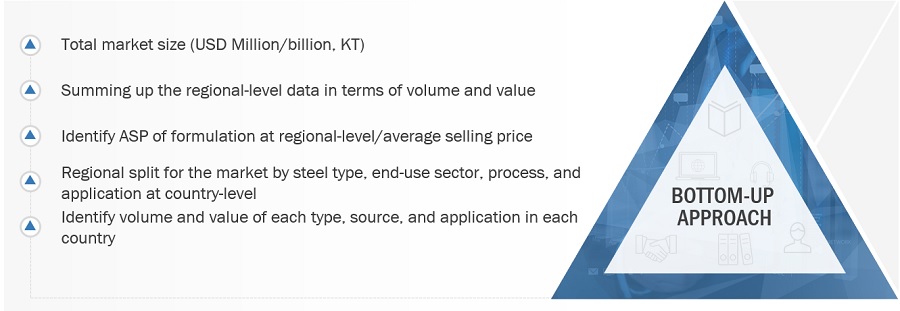
To know about the assumptions considered for the study, Request for Free Sample Report
Sintered Steel Market: Top-Down Approach
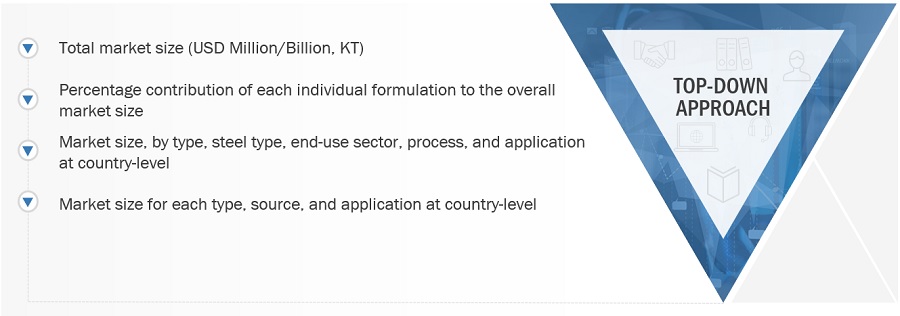
Data Triangulation
After arriving at the overall market size, the total market was split into several segments and subsegments. To complete the overall market estimation process and arrive at the exact statistics for all the segments and subsegments, data triangulation and market breakdown procedures were employed, wherever applicable. Data was triangulated by studying various factors and trends from both the demand and supply sides.
Analysts use statistical tools, data modeling techniques, and market forecasting methodologies to estimate market size, growth potential, and future trends. They consider various factors such as historical data, market drivers, restraints, and industry dynamics to project the market's future performance.
Market Definition
Sintering is a powder metallurgy process that utilizes heat or pressure to compact and make solid products from metals and alloys such as steel, stainless steel, copper, aluminum, bronze, nickel, brass, and titanium. Sintered steel finds applications in automotive, electronics, electrical industries, and construction, where it improves metal strength, lifespan, and conductivity.
Sintered steel offers several advantages over traditional steel manufacturing methods. It allows for complex shapes to be formed with precise dimensional control, high material utilization, and the ability to incorporate various alloying elements. Sintered steel components are widely used in various industries, including automotive, aerospace, industrial machinery, and consumer goods, where they provide cost-effective solutions for applications requiring high strength, wear resistance, and dimensional stability.
Key stakeholders
- Raw material suppliers and producers
- Sintered steel manufacturers
- Sintered steel distributors/suppliers
- Regulatory bodies
- Local governments
Report Objectives
- To define, describe, and forecast the size of the sintered steel market in terms of value and volume
- To provide information about the factors (drivers, restraints, opportunities, and industry-specific challenges) influencing the growth of the market
- To forecast and analyze the market based on packaging type and application
- To analyze and forecast the market size with respect to five main regions, namely, Asia Pacific, North America, Europe, South America, and Rest of the World, along with their respective key countries
- To analyze competitive developments such as mergers & acquisitions, joint ventures, and investments & expansions in the market
- To analyze opportunities in the market for stakeholders and provide a detailed competitive landscape of the market leaders
- To strategically profile the key players in the market and comprehensively analyze their core competencies
Available Customizations:
Along with the given market data, MarketsandMarkets offers customizations as per the specific needs of the companies. The following customization options are available for the report:
Product Analysis:
- Product Matrix which gives a detailed comparison of the product portfolio of each company
Regional Analysis:
- Further breakdown of the Rest of APAC Sintered steel Market
- Further breakdown of Rest of Europe Sintered steel Market
- Further breakdown of Rest of South America Sintered steel Market
- Further breakdown of Rest of Middle East & Africa Sintered steel Market
Company Information:
- Detailed analysis and profiling of additional market players (up to 5)












Growth opportunities and latent adjacency in Sintered Steel Market